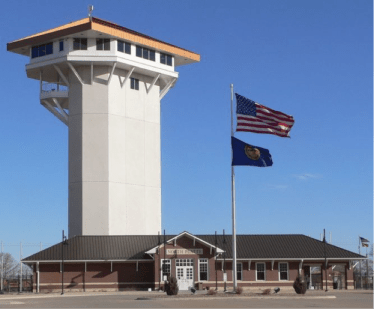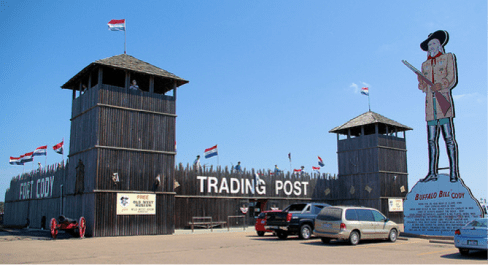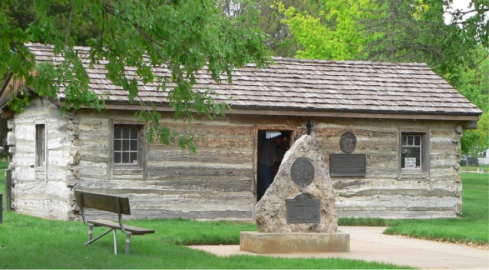A Slice of Life
Bill Lites

Day 13 (Wednesday)
This morning I headed east on I-80,across the border into Nebraska, to visit my first museum, the Mansion on the Hill Museum located in Ogallala, NE. This is the restored 1887 Victorian residence of former Opallala banker, H. L. Williams, and his family. The museum is beautifully furnished with original period furnishings, and includes a servant quarters. Other buildings on the premises include a 1902 one-room school house and an early 1900 homestead dwelling.

Just around the corner and up the street, I checked out the Boot Hill Cemetery there in Ogallala. Buried there are people from all walks of life, who found themselves in Ogallala, NE (Cowboy Capital) at the end of their life for whatever reason. RIP.

Now I headed east on I-80 again, and was hoping that Greta could help me find the Buffalo Bill Ranch located on the west side of North Platte, NE. The original Second Empire style home was built in 1886, and resides on what is now the 25 acre Buffalo Bill Ranch State Historical Park (also known as Scout’s Rest Ranch) adjacent to Scout Creek. The house is furnished with period furnishings, and includes servant’s quarters, an ice house, and a large barn.

As I headed toward North Platte, I stopped to visit the Lincoln County Historical Museum & Village, located just south of the North Platte River. This was another frontier village type museum, located on 8-acres, with a main building displaying local central Nebraska historical artifacts and memorabilia. There is also a restored early 1800’s “Main Street” town with several period buildings including; general store, schoolhouse church, blacksmith shop, and barn.

While I was in the area, just south a couple of miles, I visited the Golden Spike Museum & Baily Yard. The museum was an unusually shaped 8-story structure that gave the visitor a grand view of the huge “Baily Yard” operated by the Union Pacific Railroad. I had seen many very long coal trains during this trip, and I asked the tour guide how long the trains were. He said, “From 125 to 145 cars. We have a length restriction of 8-miles.” I was stunned, and asked him why 8-miles and he said, “Because the sidings are only 9-miles long, and the train has to fit on the siding.” Then I asked him how much coal each car could carry, and said, “Each car can carry 100 tons of coal, and each coal car weighs 20 tons.” I did the math. WOW! What a load! What did you get? I guess that’s why there are two diesel engines pulling and two diesel engines pushing those long coal trains across the open plains.

Now I headed across the north part of North Platte to visit the Cody Park Railroad Museum located just north of the North Platte River. This is a small museum with local Union Pacific artifacts and memorabilia in the restored train depot, and the only Challenger 3900 series steam locomotive on public display. The museum also has several nicely restored items of rolling stock attached to the locomotive.

Greta took me on U.S.83 south thru the city, across the South Platte River back toward I-80 to visit the Fort Cody Trading Post. This looked to me like nothing more than a big tourist trap, so I took a couple of photos and was on my way east on I-80.

I had picked up a brochure for a Pony Express station museum somewhere along the way on this trip, and planned to stop and check it out now if time permitted. I took the #211 exit off I-80, turned north across the North Platte River, into the city of Gothenburg, NE. I found the Pony Express Station Museum on the south edge of Ehmen Park in the middle of town. The museum was a restored one-room log cabin that had originally been used as a fur trading post and ranch house before being used as a Pony Express Station in 1860 – 1861.

The curator gave me a lot of information about the Pony Express that I had never known. First of all, I had no idea that the Pony Express was only in operation for 19 months in 1860-1861. Started by three business men in 1860, it was initially called the Leavenworth & Pike’s Peak Express Company, and provided “fast” (10 days) mail service between St. Joseph Missouri and Sacramento, California. The approximately 1900 mile route consisted of 120 riders, 157 Pony Express stations (spaced every 10 miles), 400 horses, and was manned by several hundred men. The express rider would stop at each station, change to a fresh horse, taking only the mail pouch called a mochila (Spanish for pouch) with him. The mochila was thrown over the saddle and held in place by the weight of the rider sitting on it. The mochila could carry 20 lbs. of mail in four pockets (two on each side) that would be padlocked.

The initial price was $5.00 per ½ ounce to send mail by the Pony Express route. The transcontinental telegraph (Telegraph Act, authorized by congress in 1860) completed in 1861, put an end to the Pony Express, and it is said the investors lost over $200,000 (1860 dollars) during the short period of time their mail service system was in operation.

After that informative stop, I told Greta it was time to find my motel for the night, located down the road a ways in Cozad, NE. She did a good job, and before I knew it, I was there and checked in. The desk clerk informed me that there were very few restaurants in town that he could recommend, and directed me toward the ones he thought best. I looked them over and selected the El Paraiso Mexican Restaurant, where I had one of the best combination plates of chili relleno, enchilada and taco dinner I’ve had in a long time. Yummm!

—–To Be Continued—–



I wouldn’t have minded being along to see some of those restored mansions. I did enjoy reading about them and about the pony express. In my book you are one of the best writers I know.
LikeLike
Now that we are back in Florida, we need to get together with Fred and Judy and eat Mexican food!
LikeLike